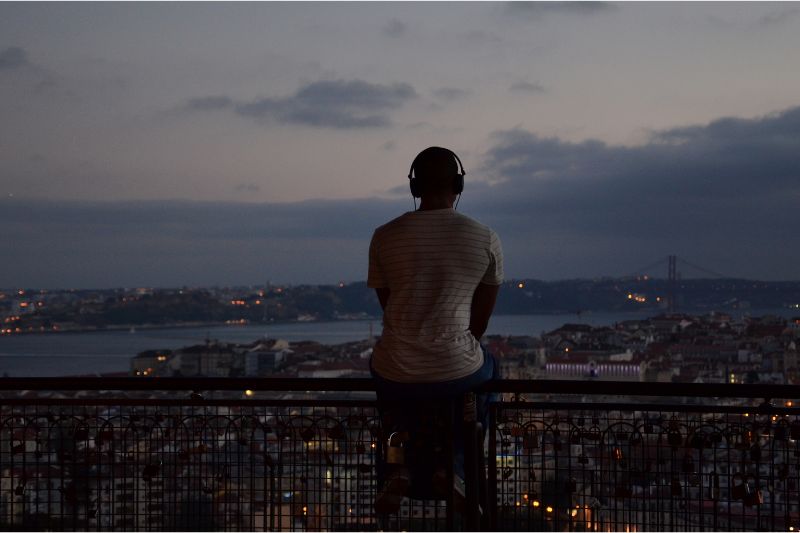When a person leaves his or her home country to start over in another place, he or she is often faced with a complex emotional process known as migratory mourning.
This term describes the feelings of loss, homesickness and adjustment that millions of immigrants around the world experience. Acknowledging this is not a sign of weakness, but a fundamental step in healing, rebuilding and enjoying a new life.
In cities such as Miami, New York, Houston or Los AngelesThousands of Latin Americans live with this experience every day. Missing family, adapting to a different language or facing new customs is not easy. That is why talking openly about migratory mourning is vital.
What is migratory grief?

The migratory mourning is the psychological and emotional process that every person goes through when moving from their country of origin to another, especially when this change implies leaving behind loved ones, customs, language and ways of life.
Unlike a mourning for physical loss, here there is no definitive closure: the homeland still exists, but the distance and the impossibility of sharing the day-to-day generates a deep vacuum.
At United Stateswhere more than 60 million Latinosthe migratory mourning is an everyday phenomenon. Every migration story is different, but they all share a sense of fracture between what is left and what is begun.
Specialized psychologists have described this process as a "multiple mourning". where the language, the landscape, the routine, the close affections and the immediate belonging to a community are lost. It is not a single loss, but several at the same time, which intensifies the emotional challenge.
The phases of migratory grief

As with other types of grief, migratory grief has phases that do not always occur in a linear fashion, but that help us understand what we are feeling.
1. Denial
In the first months of arriving in United StatesMany of us feel that euphoria for change. Everything seems new, exciting, full of opportunities.
However, this intensity sometimes hides a form of denial, avoiding thinking about what was left behind, minimizing the pain and trying to ignore the nostalgia.
Denial functions as a defense mechanism. It helps to cope with initial shockIf it is prolonged too long, it can prevent the person from processing reality.
2. Sadness
Over time, the so-called "honey moon"of migration. Cultural differences weigh, the language barrier becomes more noticeable and the distance becomes tangible. In this phase of the migratory mourning melancholy, easy crying, feeling of loneliness and even irritability predominate.
At this stage, it is common to experience mixed feelings, pride for having taken the step of migrating, but also guilt for not being with the family at important moments such as the holidays. Christmas traditions.
3. Adaptation
As months or years go by, we begin to accept reality. The sadness does not disappear completely, but it is integrated into daily life.
New routines are developed, local friendships are formed, customs of origin are combined with new traditions, and we begin to find those new habits, new customs and new traditions. sweets that we liked so much, those messages from mom...
This phase of the migratory mourning marks the beginning of resilience: the ability to build a hybrid identity, where being an immigrant becomes a strength.
Adaptation does not mean forgetting. It means recognizing that it is possible to live with nostalgia without it paralyzing the present.
Strategies for Coping with Migratory Grief

Healing the migratory mourning does not mean to stop missing, but to learn to live with the absence in a healthy way.
Search for support networks
One of the keys to facing the migratory mourning is not to be left alone. The United States has with multiple community organizations, churches and immigrant groups that provide companionship, legal and emotional counseling.
Connecting with people who share the same experience as us helps us feel understood and reduces isolation.
In cities such as Houston there are latin cultural centers that organize workshops, gastronomic events and meetings where sharing migration stories becomes a collective relief.
Maintaining cultural ties
Living in another country does not imply abandoning one's identity. Cooking typical disheslistening to music in Spanish, reading authors from your country or teaching the language to your children are ways to keep the cultural link alive.
In cities with a high Latino presence, such as Miami or Houston, Stores and restaurants abound that allow you to recreate the flavors and aromas of home, which is a balm for the soul.
Even in places where the Hispanic community is smaller, such as some areas of the Midwest, the Internet and social networks become allies in maintaining those ties.
Generate new rituals
The migratory mourning also heals by creating routines of one's own in the new country. Celebrating birthdays with new friends, integrating local traditions (such as the 4th of July or Thanksgiving) and combining your own holidays with American customs strengthens the sense of belonging.
Some immigrants choose to celebrate Christmas on two dates, the 24th with typical food from their country and the 25th with American dishes. This type of hybrid ritual helps to feel that the old has not been lost, but rather expanded with the new.
Taking care of emotional health
The migration is a challenge that can affect mental health. Therefore, it is advisable to consult professionals if the pain is too prolonged. At United States There are bilingual psychologists specializing in immigrants who understand the particularities of the immigrant community. migratory mourning.
It is also important to take care of the body, exercise, sleep well, maintain a balanced diet and practice relaxation techniques such as yoga, conscious breathing or meditation. The physical well-being supports emotional stability.
Strengthening personal projects
Having clear goals helps to focus on the positive. Whether it's study English, save for a house, start a business, start a business, etc. or completing studies, personal projects provide motivation and reduce the feeling of emptiness.
The migratory mourning becomes more bearable when it becomes an engine for growth and reinvention.
The immigrants who are able to channel their emotions toward concrete goals often find a deeper purpose in the migration experience.
Migratory grief in families and children

The migratory mourning not only adults experience it. Children also feel the separation from their friends, grandparents and familiar surroundings. Although they often adapt more quickly to the new language and school, they also experience sadness or behavioral changes.
At United Statesimmigrant parents face the challenge of balancing the integration of their children with maintaining their roots.
Speaking in the language home, telling family stories and traveling to visit when possible are ways to reduce the impact. The adolescentscan, for their part, live the mourning with higher intensity by feeling torn between two identities.
The second generation and the cultural legacy
The children of immigrants born or raised in the U.S. United States do not always feel the migratory mourning directly, but they inherit the nostalgia of their parents. Many grow up between two worlds: the Latino-customed home and the U.S. society around them.
When parents convey pride in their children's culture of originWhen the grief is not processed and is lived with resentment, children often integrate both identities in a healthier way. On the other hand, when grief is not processed and is lived with resentment, children may feel confusion or rejection towards their roots.
The importance of recognizing the process
One of the most common traps is the denial of the migratory mourning under the idea that "you have to be strong" or "there is no time to cry". However, accepting that it exists is the first step to healing. It is not weakness, but an inevitable human process when leaving a country behind, even if the decision was voluntary.
Recognizing this also helps not to idealize either the country of origin or the country of destination. It is possible to love Venezuela and at the same time build a full life in United States. The human heart is capable of sustaining both loyalties.
Accepting migratory grief also means being open to ask for help. More and more institutions in USA USA. offer free or low-cost services for the mental health of immigrants, which shows that it is not an individual problem, but a shared experience.
Healing to reinvent oneself

Healing the migratory mourning It does not mean forgetting or cutting ties, but making nostalgia coexist with gratitude for the new. It means crying when needed, but also laughing when discovering opportunities that seemed impossible before.
Those of us who go through this journey discover that migration transforms us into more resilient people, with a broader identity and the ability to move between cultures.
United Stateswith its diversity and mix of nationalities, offers a fertile space for this process to occur.
The migratory mourning is a silent reality that affects millions of immigrants in the United States.
Recognize it and heal it is the key to reinvent ourselves far from home without losing who we are. In the end, it is not a matter of choosing between the past or the present, but of learning to inhabit both with dignity and hope.
At CuriaraWe know what it means to leave your homeland behind and face the migratory mourning. We understand what it's like to miss, adapt, struggle and learn to rebuild yourself away from home. That's why we want to accompany you in this process, reminding you that you are not alone and that it is always possible to reinvent yourself without losing the essence of who you are.
